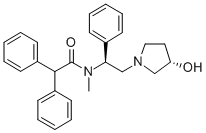153205-46-0
 153205-46-0 結(jié)構(gòu)式
153205-46-0 結(jié)構(gòu)式
基本信息
N-((S)-2-((S)-3-羥基吡咯烷-1-基)-1-苯乙基)-N-甲基-2,2-二苯基乙酰胺
ASIMADOLINE
Asimadoline (EMD-61753
EMD-61753
EMD61753
EMD 61753
N-((S)-2-((S)-3-Hydroxypyrrolidin-1-yl)-1-phenylethyl)-N-methyl-2,2-diphenylacetamide
Benzeneacetamide, N-[(1S)-2-[(3S)-3-hydroxy-1-pyrrolidinyl]-1-phenylethyl]-N-methyl-α-phenyl-
N-[(1S)-2-[(3S)-3-Hydroxy-1-pyrrolidinyl]-1-phenylethyl]-N-methyl-alpha-phenylbenzeneacetamide
物理化學(xué)性質(zhì)
常見問題列表
IC50: 5.6 nM (guinea pig κ opioid), 1.2 nM (human recombinant κ opioid)
Asimadoline (EMD-61753) has high selectively in κ: μ: δ opioid binding ratios of 1:501:498 in human recombinant receptors. The IC
50
for Asimadoline binding to μ-opioid receptors is 3 μM and to δ-opioid receptors is 0.7 μM. The IC
50
values for D1, D2, kainate, σ, PCP/NMDA, H1, α1, α2, M1/M2, glycine, 5HT1A, 5HT1C, 5HT1D, 5HT2, 5HT3, AMPA and kainate/AMPA receptors are all >10 μM.
Asimadoline has affinity to sodium and L type Ca
2+
ion channels at IC
50
concentrations 150 to 800 fold the IC
50
for the κ receptors.
At high concentrations, Asimadoline demonstrates spasmolytic action against 400 μM barium chloride in the rat duodenum (IC
50
=4.2 μM), suggesting that Asimadoline may block the direct stimulant effects of barium on smooth muscle through mechanisms that are not identified.
Asimadoline (EMD-61753; 1, 5, 15 mg/kg; s.c.) acutely ameliorates both formalin-evoked hyperalgesia and tactile allodynia in diabetic rats.
The absorption rate following oral administration is 80% in rats and >90% in dogs and monkeys. The metabolism of Asimadoline is rapid and appears similar in animals and man. Asimadoline has peripheral anti-inflammatory actions that are partly mediated through increase in joint fluid substance P levels.
Treatment with Asimadoline (5 mg/kg/day; i.p.) produces marked (and sustained) attenuation of the disease with all three time regimes.
| Animal Model: | Adult female Sprague-Dawley rats |
| Dosage: | 1, 5, 15 mg/kg |
| Administration: | SC; single dose |
| Result: | Acutely ameliorated both formalin-evoked hyperalgesia and tactile allodynia in diabetic rats. |
